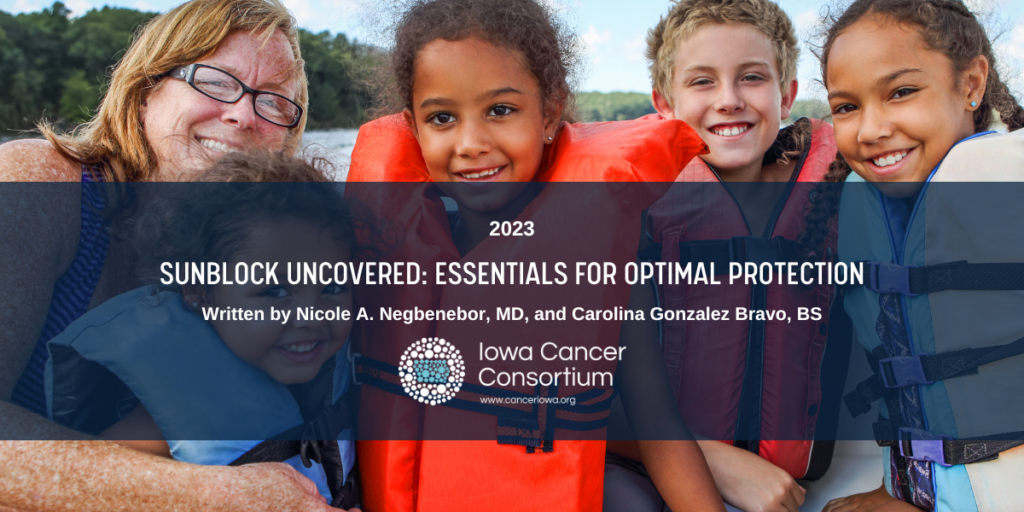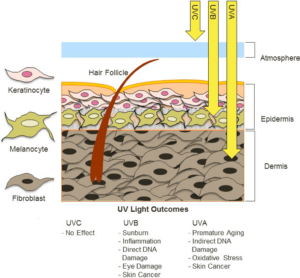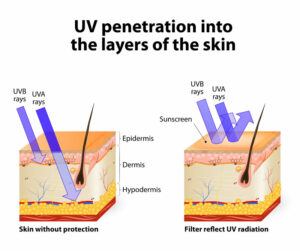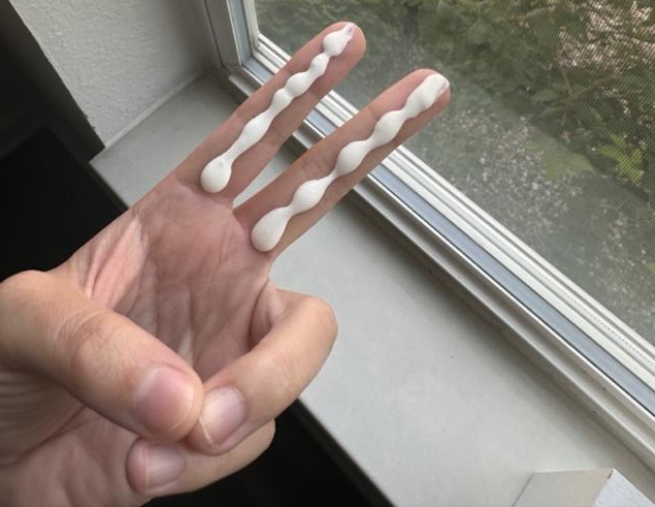Sunblock Uncovered: Essentials for Optimal Protection

Authors: Carolina Gonzalez Bravo, BS & Nicole A. Negbenebor, MD
The summers in Iowa are known for their warm temperatures. Whether it is going to a farmer’s market, spending the day at a golf course, or enjoying quality time with loved ones at a park– summer brings warmth and an opportunity to engage in outdoor activities. Nevertheless, the sun’s ultraviolet (UV) rays are the strongest during the summer. This increases our risk of sunburn and long-term skin damage. This sun damage can contribute to photoaging (permanent damage to the skin), premature aging, wrinkle formation, and increase our risk for skin cancer.
Sun exposure is cumulative. The sun exposure that an individual accumulates during their lifetime (i.e., early-life sunburns and repeated sunburns) contributes to their overall risk of developing skin cancer later in life. The most common types of skin cancer associated with sun exposure are basal cell carcinoma, squamous cell carcinoma, and melanoma. Implementing a combination of sun-safety behaviors such as wearing protective clothing, using sunscreen, seeking shade, and avoiding tanning beds can minimize your risk for skin cancer. Sunscreen should be used daily year-round, and the summer can be a great opportunity to form this new habit if you haven’t already done so!
What is sunscreen?
Sunscreen – also known as sunblock – is a topical product that is used to shield your skin from UV radiation. Your skin consists of many cells that contain DNA. Overexposure to UV radiation can damage this DNA. While your cells have mechanisms to correct this damage, excessive UV radiation can also introduce mutations that can lead to the development of skin cancer. Sunscreen can absorb or reflect that UV radiation to minimize the amount that penetrates your skin.
 Citation: https://www.mdpi.com/1420-3049/19/5/6202
Citation: https://www.mdpi.com/1420-3049/19/5/6202
What is the difference between UVA and UVB?
There are two types of UV radiation that are emitted by the sun: ultraviolet A (UVA) and ultraviolet B (UVB). UVA (aging rays) penetrates deeper into the skin and is associated with skin cancer. UVB (burning rays) mostly affects the outer layer of the skin, helps in Vitamin D production, and is the primary cause of sunburns – which can also lead to skin cancer. You can protect yourself from both types of rays by using sunscreens that are labeled as “broad-spectrum.”
 Citation: https://www.aimatmelanoma.org/melanoma-101/prevention/what-is-ultraviolet-uv-radiation/
Citation: https://www.aimatmelanoma.org/melanoma-101/prevention/what-is-ultraviolet-uv-radiation/
What is SPF? Is higher SPF better?
SPF stands for Sun Protective Factor. Each sunscreen contains a label with a number known as SPF that ranges between 15 to 100+. This number is used to indicate the level of protection that a sunscreen can provide against UVB (but remember, a broad-spectrum sunscreen protects against both UVA and UVB, even though the SPF number is calculated based solely on UVB). You want to reapply sunscreen every two hours or after exposure to water. The best way to apply sunscreen is on dry skin 15 minutes before going outdoors.
Depending on the formulation, sunscreens work by absorbing or reflecting UV radiation.
- SPF 15 blocks 93% of UVB radiation
- SPF 30 blocks 97% of UVB radiation
- SPF 50 blocks 98% of UVB radiation
- SPF 100 blocks 99% of UVB radiation
No sunscreen on the market can block 100% of UVB rays and anything with an SPF higher than 100 is not going to provide additional protection. Intuitively, one would think that a higher SPF should be better because it means more protection. However, as you can see, the increase in blockage is minimal after reaching an SPF 30. Unfortunately, sometimes a higher SPF can lead to a false sense of security that can lead individuals to apply sunscreen less frequently.
According to the Skin Cancer Foundation, to achieve the full benefits of the SPF stated on the sunscreen bottle, it is necessary to apply two milligrams of sunscreen per square centimeter of skin. Dermatologists commonly refer to this as the “one-shot glass” rule, which is roughly equivalent to two tablespoons. Unfortunately, most individuals do not apply this amount of sunscreen. To err on the side of caution, it is advisable to use a sunscreen with the highest SPF and reapply regularly (at least every 2 hours). Dermatologists recommend selecting a sunscreen that has an SPF of at least 30 and is labeled as broad-spectrum for optimal protection.
Who should wear sunscreen?
According to the American Academy of Dermatology, everyone should wear sunscreen! Skin cancer does not discriminate which means that anyone can be diagnosed with skin cancer in any sun-exposed area regardless of their skin color, race, and/or age. The Skin Cancer Foundation recommends waiting until children are at least 6 months old before applying sunscreen.
What are the different types of sunscreens?
Sunscreens can be purchased in different forms: lotions, sticks, creams, gels, and even sprays. Some forms are more suitable than others depending on the activity and the amount of skin you are trying to protect. There are two major classifications of sunscreens: physical (mineral) and chemical. Both protect against UVA and UVB. Chemical sunscreens absorb UV radiation while physical sunscreens reflect and scatter UV radiation. Most sunscreens use a combination of both physical and chemical filters to maximize that “broad-spectrum” effect we mentioned earlier. If active and sweating, then you should apply a waterproof sunscreen.
How much sunscreen do I need? How often do I need to reapply?
There are many tricks that individuals use to remember how much sunscreen to use. If you are applying a lotion/cream-based sunscreen, you can follow the one shot glass (two tablespoons) rule. This is the amount of sunscreen that is recommended to cover your entire body. You want to apply sunscreen wherever your skin is exposed to the sun.
For daily protection of the face and neck, you can follow the two-finger rule as shown below.

How do I pick the right sunscreen for me? What should I look for in a label?
If you walk into your local Walmart, Target, drug store, or Hy-Vee, you will find many different types of sunscreens. It is recommended that you find a sunscreen that is at least SPF 30 and labeled as broad-spectrum. We suggest that you find a sunscreen that fits your budget. Despite all the marketing that exists, there is no need to break the bank when purchasing a sunscreen. You will get the most protective benefits if you reapply as indicated on the bottle and are generous on application!
Is using sunscreen safe?
Sunscreens are safe when used as directed and are widely recommended by dermatologists. There is extensive research to support the use of sunscreen. The alternative, which is not using sunscreen, is far more dangerous than any FDA-approved sunscreen that you could purchase at your local store. The FDA is in charge of regulating sunscreen to ensure it is safe for all of us to purchase and use. If you still have concerns about sunscreen use, make sure to read the label to ensure it is FDA-approved and try purchasing a sunscreen from a well-established reputable brand.
Will daily sunscreen use cause me to have Vitamin D deficiency?
Research suggests that sunscreen does not decrease Vitamin D concentrations. If this is still a concern for you, you can supplement or obtain Vitamin D from nutritional sources such as fatty fish and/or fish liver oils.
Resources for More Information:
- University of Iowa Dermatologist offers sun safety tips for the summer months
- University of Iowa Hospitals & Clinics Sun Safety Article
- University of Iowa Holden Comprehensive Cancer Center Skin Safety
- American Academy of Dermatology Sunscreen FAQs
- Skin Cancer Foundation Sun Protection Guide
- CeraVe “What is Sunscreen?” Article
References:
- How to decode sunscreen labels. Accessed June 18, 2023. https://www.aad.org/public/everyday-care/sun-protection/shade-clothing-sunscreen/understand-sunscreen-labels
- Neale RE, Khan SR, Lucas RM, Waterhouse M, Whiteman DC, Olsen CM. The effect of sunscreen on vitamin D: a review. Br J Dermatol. 2019;181(5):907-915. doi:10.1111/bjd.17980
- Office of the Commissioner. Facts about Sunscreen. U.S. Food and Drug Administration. Accessed June 18, 2023. https://www.fda.gov/news-events/rumor-control/facts-about-sunscreen
- Skin Cancer Foundation. Ask the expert: How much sunscreen should I be using on my face and body? The Skin Cancer Foundation. Published February 20, 2019. Accessed June 18, 2023. https://www.skincancer.org/blog/ask-the-expert-how-much-sunscreen-should-i-be-using-on-my-face-and-body/
- Sunscreen. The Skin Cancer Foundation. Published March 8, 2019. Accessed June 18, 2023. https://www.skincancer.org/skin-cancer-prevention/sun-protection/sunscreen/
- Sunscreen FAQs. Accessed June 18, 2023. https://www.aad.org/media/stats-sunscreen
- Taylor S, Diffey B. Simple dosage guide for suncreens will help users. BMJ. 2002;324(7352):1526. doi:10.1136/bmj.324.7352.1526/a
- Jewell T, Strauss R. The ultimate sunscreen guide, according to dermatologists. Healthline. Published June 20, 2018. Accessed June 18, 2023. https://www.healthline.com/health/beauty-skin-care/sunscreen-guide
Disclosure & Disclaimer
With the summer approaching, this article is for educational purposes only. The authors do not endorse any sunscreen brands and are not receiving monetary compensation from any sunscreen brands. For specific questions about sunscreen use, we recommend contacting your primary care provider and/or your dermatologist. Have a safe summer!
About the Authors

Dr. Nicole A. Negbenebor, MD
Originally from the South, Dr. Nicole A. Negbenebor is a graduate from Yale University and the Warren Alpert Medical School of Brown University. She did her dermatology residency at Brown and is a board-certified dermatologist. She is a fellow in Mohs Micrographic Surgery and Cutaneous Oncology at the University of Iowa. She is passionate about Mohs, advocacy, skin of color, and UI women’s basketball.

Carolina Gonzalez Bravo, BS
Carolina is a rising third-year medical student at the University of Iowa, Carver College of Medicine (UI CCOM). She serves as the Dermatology Interest Group (DIG) Co-President and as an LMSA Midwest Policy and Academic Affairs Chair. She is passionate about advancing health equity, promoting diversity in the physician workforce, mentorship, and Barre3.
